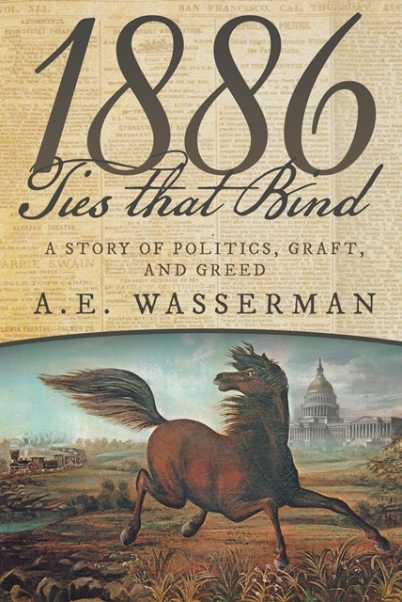It’s Not There by A.E. Wasserman
It’s not there. Not now. Hasn’t been for a long time. It’s a mirage in the mind. A memory on the wind. I never saw it. I can only imagine it. The largest lake west of the Mississippi. Larger even than Lake Tahoe. It was the vast Tulare Lake.I’m sitting beside the Settlers Ditch that was originally built to tie into the lake-that-isn’t-there, watching the water flow by at quite a clip. It carries melted snow down from the High Sierras into California’s Central Valley. Designed to control where the runoff water went, to protect fields from flooding while providing water for them at the same time, it’s a little canal, hand dug by settlers nearly a century and a half ago. Called a ditch in these parts, it’s maybe six feet wide, three feet deep. Large or small, it doesn’t matter. In California, it’s all about the water. Always has been. Always will be.
A twig bobs past like a mini-raft while my dog, Topper, stretches down the embankment and laps up a cold drink on this warm spring day. He was born just a couple ranches over. My own ranch is an hour east, up in the foothills of the Sierras. I love both the jagged mountains and these flat ranch lands equally, but for different reasons. Today I sit here on the steep old ditch bank. I share the sun with the fields. I look back up at the snowcapped peaks.
The Tulare Lake was the terminus for the watershed off those southern Sierra Mountains as well as much of the coastal mountains to the west. The lake was a natural water basin where wildlife abounded. People think of the California Gold Rush as what first made California wealthy, but the real gold was the water.
Watching the sun splinter off the rippling current, I hear the whispers of the past. The slight breezes carry the land’s memories and I listen.
For ten thousand years, the Native Americans thrived around the massive lake. The Yokuts came down from the Sierras to fish and hunt when the winter snows closed in; there were pow-wow gatherings with the coastal Chumash who came to trade shells and ocean fish for woven tule baskets. Here, the lake offered trout, salmon, sturgeon, mussels and terrapin. The woods surrounding the water was home to herds of antelope, deer, and elk, to solitary cougars, and majestic grizzly bears. The riparian areas were perfect for the willows and cottonwoods as well as tule reeds.
When white settlers arrived, often disillusioned seekers of gold, they envisioned more, wanting to claim land and build homesteads. Welcoming them, the Native Americans who wintered in the foothills, including what is now my ranch, guided white man to see the giant Sequoia trees and the breath-taking Yosemite Valley. All the peoples, the settlers, the natives, were friendly. The Tulare Lake provided the water they needed, and the vast valley offered sixty thousand square miles of land. There was plenty for everyone.
While researching for my novel 1886 Ties That Bind, I found one first-hand account from 1857 that offers a description of the lake. The settler, Mr. J.M. Barker, had started out on horseback one November day with an “old Englishman,” his neighbor, to search for some horses of theirs that had “strayed away.” Little did he know the massive earthquake of 1857 would strike.
We shaped our course to skirt the shores of Tulare Lake, between what is known as Cross Creek and Kings River. At this time Tulare Lake was a very large sheet of water, about one hundred miles in length by thirty miles in width at its widest place.
I dismounted and led my horse by the bridle, and walked to the edge of the water to look for tracks. Just as l reached it, the ground seemed to be violently swayed from east to west. The water splashed up to my knees; the trees whipped about, and limbs fell on and all around me. I was affected by a fearful nausea, my horse snorted and in terror struggled violently to get away from me, but I hung to him, having as great a fear as he had himself. Of course, all this occupied but a few seconds, but it seemed a long time to me. The lake commenced to roar like the ocean in a storm, and, staggering and bewildered, I vaulted into the saddle and my terrified horse started, as eager as I was to get out of the vicinity.
I found my friend, who had not dismounted, almost in a state of collapse. He eagerly inquired, while our horses were on the run and the lake was roaring behind us, "What is this?" I replied, "An earthquake! Put the steel to your horse and let us get out of this!" and we ran at the top of our speed for about five miles.
We observed several hundred antelopes in a state of the wildest confusion and terror. They ran hither and thither, creating a great dust, stumbling and falling over each other in mortal fear.
We returned the next day and found that the lake had run up on the land for about three miles. Fish were stranded in every direction and could have been gathered by the wagon-load. The air was olive with buzzards and vultures eager for the feast, but the earth had acquired its normal condition.
By 1886, fictional Sally Baxter, the strong ranch gal in my novel, had a ranch along the Settler’s Ditch, dug a dozen years earlier. She was just north of the Tulare Lake and like all the ranchers in the area, her family depended on the newer ditch and lake system. Water was diverted from the lake during the dry season into other ditches leading to fields. But it wasn’t long before the settlers and ranchers needed more land to grow more crops and run more cattle. As demand for the ranches continued to grow, larger canals were built, diverting the rivers that fed the lake. The lake was shrinking.
The railroad brought more opportunity and more people. The towns required more and more water management each decade. It took a good bit of time. And a lot of government money. Slowly but surely, the surface area of Tulare Lake continued to diminish as the water was controlled.
Seventy-five years after Sally ran her ranch, by the 1960’s, the last of the foothill dams was built and all the remaining water to the Tulare Lake was finally choked off.
Now, instead of fish and trees and wild game, acres of crops abound. Hay, cotton, and rice paddies. Corn fields. Tomatoes and potatoes. Onions. Wheat and grapes. Dairies and cattle. Orchards. High tech irrigation controls have been installed by corporate ranches to sustain these thirsty fields. The satellite view of California shows a vague outline of the deepest part of where the huge lake bed had once been, in spite of the earth having been plowed and planted, in spite of the crisscrossing roads or the interstate that slices it.
But from the earth, there is no resemblance of what once was there. No small forest along a water’s marshy edge. Not one antelope or elk there. Or fish. No lake. Like the California grizzly bears, the lake has vanished. Today the Native Americans are tucked away on their reservations with casinos. I wonder if they even have pow-wows with one another. I should stop and visit some of the elders and ask.
I am sad about what was that is no more.
But I understand why. Producing food is vitally important. Supply chain. Development. Progress. Profit.
Today I am sitting smack dab in the middle of a forty two billion dollar agricultural industry. Forty. Two. Billion. I cannot even imagine how much money that is. Debates can go on about the pros and the cons—if trading the lake away was a good thing or not. It doesn’t matter because it’s done. I eat the food that’s grown here as do so many others.
But I wish I’d seen Tulare Lake—paddled a canoe around its marshy edges, caught sight of a bald eagle, or glimpse a small kit fox.
Topper comes over for an ear scratch, which I happily provide.
What will the next century bring to the Valley? How will it change the face and the function of this wonderful place? I don’t know any more than the Yokut Indians did in the early part of the 19th Century. I write historical novels, not futuristic ones. My heart picks up the past when I sit still, open to the stories. I listen to those echoes and picture what it must have been like. I travel back in time in my mind’s eye to find the tales the wind is telling. Change brought us from “then” to “now.” While the future doesn’t come to me on the wind, it is a given that from today on there will be more changes—some we can predict, others not.
Today will become history. Some historical writer in the future may very well research the past, wondering what life was like way back in 2018, when I was sitting on the banks of the Settler’s Ditch with a Border Collie named Topper, remembering a lake-that-isn’t-there.
1886 Ties That Bind: A Story of Politics, Graft, and Greed by A.E. Wasserman
Publication Date: November 8, 2016
Archway Publishing
Hardcover, Paperback, & eBook; 370 Pages
Series: Langford Series, Book #2
Genre: Fiction/Historical
It is 1886 as Englishman Lord Langsford travels by train to San Francisco. Newly widowed, Langsford is desperate to escape his grief, demons, and life in England. As Langsford completes the last leg of his transcontinental journey, his life unexpectedly changes once again when he crosses paths with Miss Sally Baxter, a beautiful rancher who packs a pistol in her purse.
Sally has made it her mission to find the men who robbed a train and killed her brother. Unfortunately, no one—not even the owners of the Southern Pacific Railroad—seem to care. Unable to resist her pleas, Langsford offers to help Sally and soon becomes entangled in a web of politics, corruption, and greed. As murder, threats, and attacks ensue that endanger both Sally and Langsford, influential men in both California and Washington, D.C. jockey for positions of power. Langsford, who finds himself oddly attracted to Sally, now must sort through criminals and politicians alike to discover the truth behind her brother’s death and prevent his own murder.
“Not only is this a fast-paced historical mystery, 1886 Ties That Bind offers commentary on the political and social issues that are still relevant today.” – Helga Schier, PhD, author and founder of With Pen and Paper
"Wasserman’s writing is atmospherically rich. Very strongly recommended." – Historical Novel Society, London, critical review of 1884 No Boundaries
Amazon US | Amazon UK | Barnes and Noble
About the Author
 The daughter of a newspaperman, A.E. Wasserman grew up in a household filled with books and stories. At age 14, she wrote her first novella and never stopped writing.
The daughter of a newspaperman, A.E. Wasserman grew up in a household filled with books and stories. At age 14, she wrote her first novella and never stopped writing.She is the author of a new mystery/thrillers series, the first of which takes place in London: 1884 No Boundaries, A Story of Espionage and International Intrigue. The second in the Langsford Series, 1886 Ties That Bind, A Story of Politics, Graft and Greed, has just been released.
Her work, critically acclaimed as “richly atmospheric,” is being noticed by readers and critics alike, and has garnered international attention, not only in the U.S., but Europe and the U.K. as well. She recently received top honors from Writer’s Digest for her work.
After graduating from The Ohio State University, she lived in London, then San Francisco. Currently she resides in Southern California with her family and her muse, a Border Collie named Topper.
For more information, please Visit the author’s web site at www.aewasserman.com. You can also connect with her on Facebook and Twitter.
Blog Tour Schedule
Tuesday, February 27Feature at Passages to the Past
Saturday, March 3
Excerpt at Encouraging Words from the Tea Queen
Sunday, March 4
Interview at T's Stuff
Wednesday, March 7
Excerpt at Let Them Read Books
Friday, March 9
Feature at What Is That Book About
Monday, March 12
Interview at Donna's Book Blog
Thursday, March 15
Review at Locks, Hooks, and Books
Tuesday, March 20
Review at Teaser Addicts Book Blog
Thursday, March 22
Review at Impressions in Ink
Friday, March 23
Excerpt at A Literary Vacation
Friday, April 6
Interview at Passages to the Past
Giveaway
During the Blog Tour we will be giving away two eBooks of 1886 Ties That Bind by A.E. Wasserman! To enter, please enter via the Gleam form below.Giveaway Rules
– Giveaway ends at 11:59pm EST on April 6th. You must be 18 or older to enter.
– Giveaway is open INTERNATIONALLY.
– Only one entry per household.
– All giveaway entrants agree to be honest and not cheat the systems; any suspect of fraud is decided upon by blog/site owner and the sponsor, and entrants may be disqualified at our discretion.
– Winner has 48 hours to claim prize or new winner is chosen.
1886


















No comments:
Post a Comment